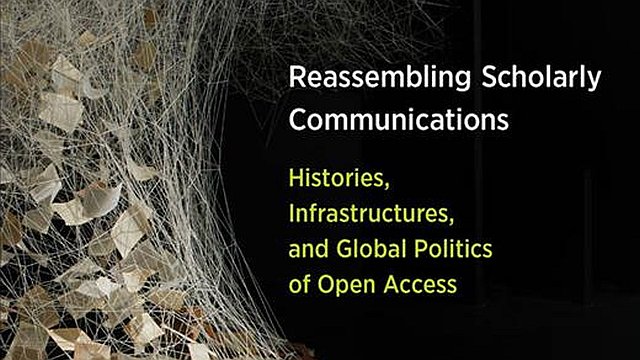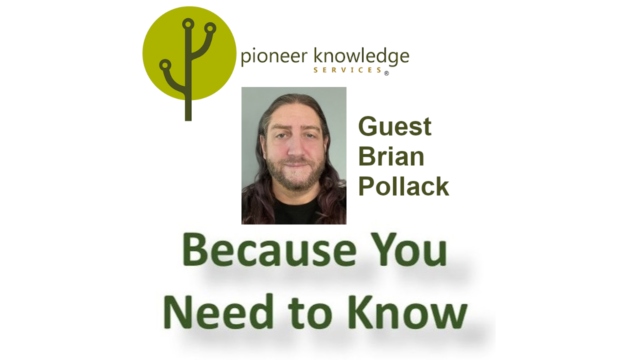
A proposal for open knowledge and open knowledge management
Open innovation has become a key trend in innovation theory and practice. It can be described as “combining internal and external ideas as well as internal and external paths to market to advance the development of new technologies.”
In a previous RealKM Magazine article, Adi Gaskell revealed how effective internal structures are needed for companies to be able to absorb external innovation, and that employees appear to require a certain level of education to be able to successfully apply open innovation methods.
We’ve also seen how knowledge management makes an important contribution to innovation, with a pivotal aspect of open innovation being that companies must extend their reach to external sources of valuable knowledge.
A new paper1 takes this one step further by proposing that it’s time to move to “open knowledge” and “open knowledge management.” The paper is being presented at the International Federation of Library Associations and Institutions (IFLA) 2017 satellite conference New Directions in Knowledge Management.
The paper contends that in traditional enterprise knowledge management theory and practice, internal knowledge is the primary target of research and operation. External knowledge and the flows of knowledge across the organisation boundary are ignored, which risks turning the organisation into an island in the open innovation environment.
Progressive opening-up in the business environment is seen as a key facilitator of open innovation. Three stages of opening-up factors are identified:
- Stage 1, end of 20th century. Opening of market and policy factor, including the emergence of knowledge workers, maturity in the transaction of ideas, improvements in external supply, and the enhancement of regional cooperation.
- Stage 2, beginning of 21st century. Opening of technology factor, including open source, open collaboration, open community, open tools, open platforms, open access, and open infrastructure.
- Stage 3, 2009-present. Opening of content factor, including open access resources, open data, open education resources, and open patents.
The paper argues that for business to take advantage of the newly emerging “open content” (stage 3), there is a need for both “open knowledge” and “open knowledge management.”
Open knowledge
The paper defines open knowledge as being generated in the open innovation environment, abiding by existing intellectual property frameworks, being a public knowledge resource, and supporting reuse, revision, remixing, and redistribution.
The properties of open knowledge are defined across two dimensions, as shown in Figure 1. The vertical axis (open property) means openness is a changing process rather than a binary status, based on the progressive classes of gratis and libre.
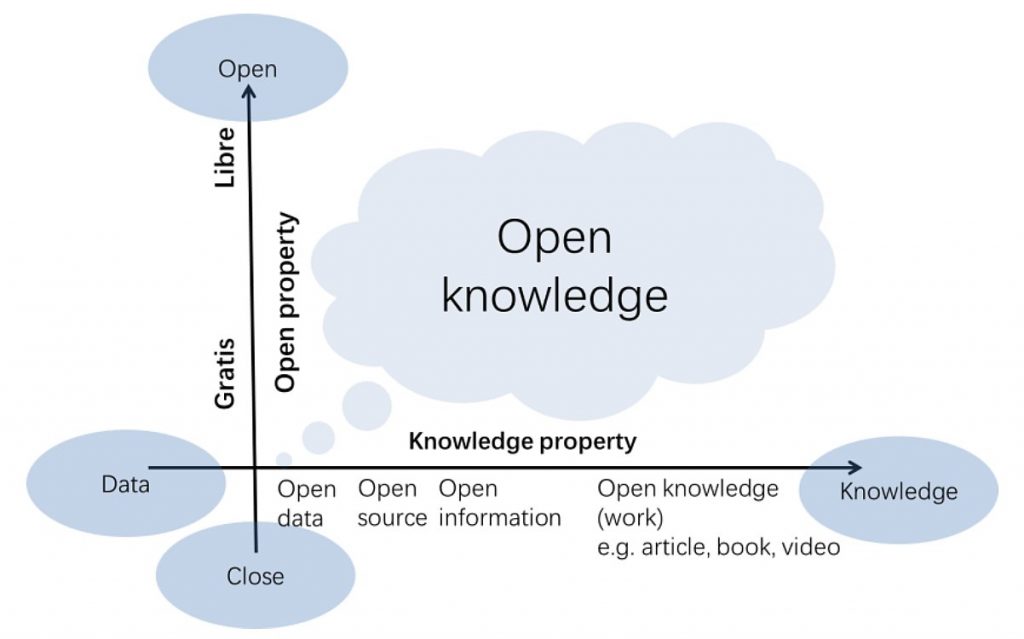
Open knowledge is represented in different ways in different sectors:
- Business. Discover, identify, and absorb external knowledge; integrate knowledge.
- Scientific exchange. Structure, semanticise, and link various types of open information to support their combination and reuse.
- Open movement. Through open policy, open tools, and open services, promote the utilisation of open resources and upgrade public service levels.
However, an open knowledge chain links the sectors, as shown in Figure 2.
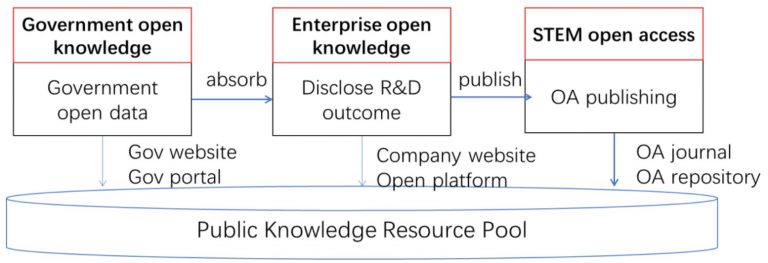
The paper identifies that the challenges in achieving open knowledge include that existing research mainly recognises open knowledge on the supply side, with a lack of unified theoretical cognition on the utilisation side, and that there are ambiguous definitions for data, information, content, knowledge, and knowledge work.
I would add that there are also challenges in regard to open data, open science, and open access (with the knowledge management profession itself being a poor performer).
Open knowledge management
Current shifts in the balance between the public domain and private province for intellectual property create the opportunity to explore open knowledge not just as a pattern, but also a governance mechanism through open knowledge management. The potential evolution of open knowledge management is shown in Figure 3.
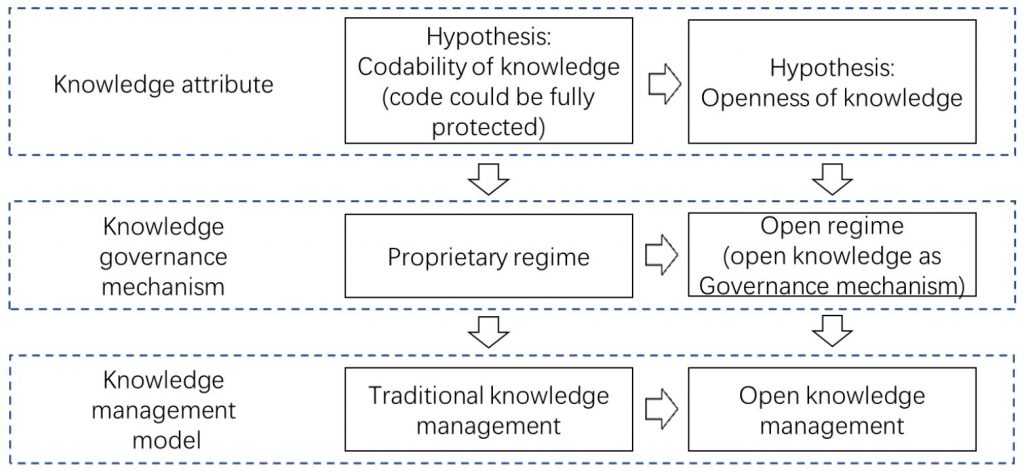
From a 2015-16 study of 20 companies in mainland China, the paper identifies an open knowledge management model based on Nonaka & Takeuchi’s SECI model of knowledge dimensions, as shown in Figure 4. The open strategy is the ultimate level of the open knowledge management model.
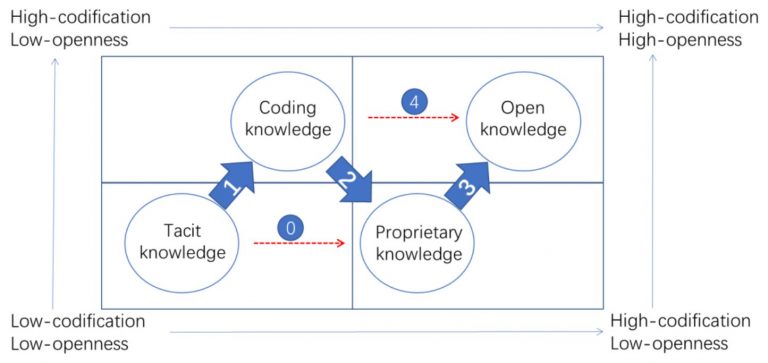
The conversion forms between knowledge types is a key aspect of the model:
- Personal proprietary (No. 0 in Figure 4). Once there has been coding, then there is a chance for knowledge to become open. Therefore, the ultimate proprietary knowledge involves no coding operation. Tacit knowledge is the ultimate proprietary knowledge.
- Born open (No. 4 in Figure 4). This is the ideal open knowledge condition. Once there has been coding, the knowledge is open for all. The organisation’s knowledge base is on Internet.
- Coding strategy (No. 1 in Figure 4). According to codification mode for knowledge management, this strategy includes constructing an intranet, optimising IT infrastructure, enriching enterprise repositories, and launching knowledge management systems.
- Proprietary strategy (No. 2 in Figure 4). Based on the coding strategy, the proprietary strategy emphasises network security and privacy, focuses on rights management and the knowledge with high classification levels, etc. The main feature of this strategy is paying attention to intellectual property.
The paper illustrates the application of the model using three of the 20 companies involved in the study, as shown in Figure 5. They are Huawei, Lenovo and Xiaomi (MI), which occupy the no. 3, 4, and 5 positions in the list of top 5 mobile phone handset makers (after Apple and Samsung). They are also ranked as highly innovative companies.
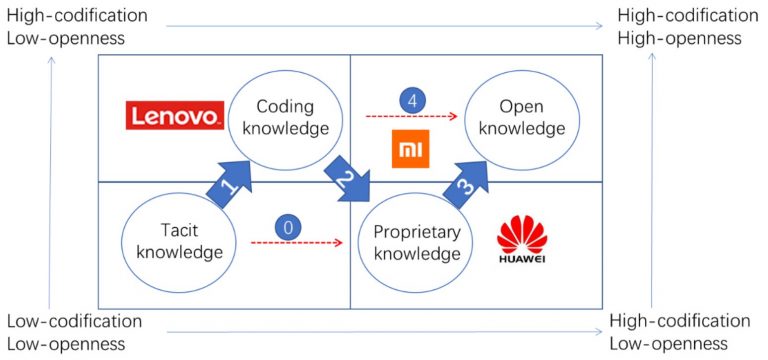
The strategies used by each of the three companies are:
- Lenovo—coding strategy. Adopted Activity Based Knowledge Management (ABKM) method, identifying every action in the work flow, then recording it in a knowledge article that is saved in the Knowledge Base. Workers and engineers are mobilised to write knowledge articles.
- Huawei—proprietary strategy. Heavy emphasis on patent application. In 2014, Huawei became the champion in patent application numbers in the world. Also implemented Employee Stock Ownership to control talent wastage rate, and a strong intellectual property administration.
- Xiaomi—open strategy. Uses a socialising technique to introduce technical knowledge to the public. Established a mature online community to listen to users. Cultivates a fan culture, involving fans in research and development.
Open knowledge management roadmap
From the study of 20 companies, the paper identifies a potential roadmap for achieving an open strategy:
- Establish an open inventory and roadmap
- Integrate internal repositories and extranet
- Extend the functions of the knowledge management section
- Construct a common cross-discipline knowledge base
- Build an open platform
- Datify
- Ontologise
- Utilise social media
- Run a user community
- Open patents
- Set the default to open.
Article source: Open Knowledge Management Model in Open Innovation Environment is licenced by CC BY 4.0.
Reference:
- Wang, Z. (2017). Open Knowledge Management Model in Open Innovation Environment. New Directions in Knowledge Management. Satellite Meeting—Knowledge Management Section 18 August 2017, 2017 International Federation of Library Associations and Institutions (IFLA) World Library and Information Congress. Wrocław University of Economics, Poland. Retrieved from http://library.ifla.org/1719/ ↩
Also published on Medium.


